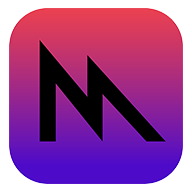Related Research Articles

OpenGL is a cross-language, cross-platform application programming interface (API) for rendering 2D and 3D vector graphics. The API is typically used to interact with a graphics processing unit (GPU), to achieve hardware-accelerated rendering.

In computing, a windowing system is a software suite that manages separately different parts of display screens. It is a type of graphical user interface (GUI) which implements the WIMP paradigm for a user interface.
QuickDraw was the 2D graphics library and associated application programming interface (API) which is a core part of classic Mac OS. It was initially written by Bill Atkinson and Andy Hertzfeld. QuickDraw still existed as part of the libraries of macOS, but had been largely superseded by the more modern Quartz graphics system. In Mac OS X Tiger, QuickDraw has been officially deprecated. In Mac OS X Leopard applications using QuickDraw cannot make use of the added 64-bit support. In OS X Mountain Lion, QuickDraw header support was removed from the operating system. Applications using QuickDraw still ran under OS X Mountain Lion to macOS High Sierra; however, the current versions of Xcode and the macOS SDK do not contain the header files to compile such programmes.

A graphics processing unit (GPU) is a specialized electronic circuit initially designed to accelerate computer graphics and image processing. After their initial design, GPUs were found to be useful for non-graphic calculations involving embarrassingly parallel problems due to their parallel structure. Other non-graphical uses include the training of neural networks and cryptocurrency mining.
Quartz 2D is the native two-dimensional graphics rendering API for macOS and iOS platforms, part of the Core Graphics framework.
X.Org Server is the free and open-source implementation of the X Window System (X11) display server stewarded by the X.Org Foundation.
Core Image is a pixel-accurate, near-realtime, non-destructive image processing technology in Mac OS X. Implemented as part of the QuartzCore framework of Mac OS X 10.4 and later, Core Image provides a plugin-based architecture for applying filters and effects within the Quartz graphics rendering layer. The framework was later added to iOS in iOS 5.
In Apple's macOS operating system, Quartz is the Quartz 2D and Quartz Compositor part of the Core Graphics framework. Quartz includes both a 2D renderer in Core Graphics and the composition engine that sends instructions to the graphics card. Because of this vertical nature, Quartz is often synonymous with Core Graphics.

Cairo is an open-source graphics library that provides a vector graphics-based, device-independent API for software developers. It provides primitives for two-dimensional drawing across a number of different backends. Cairo uses hardware acceleration when available.

OpenGL for Embedded Systems is a subset of the OpenGL computer graphics rendering application programming interface (API) for rendering 2D and 3D computer graphics such as those used by video games, typically hardware-accelerated using a graphics processing unit (GPU). It is designed for embedded systems like smartphones, tablet computers, video game consoles and PDAs. OpenGL ES is the "most widely deployed 3D graphics API in history".
Core Video is the video processing model employed by macOS. It links the process of decompressing frames from a video source to the rest of the Quartz technologies for image rendering and composition. Both QuickTime X and QuickTime 7 depend on Core Video.
In computing, hardware overlay, a type of video overlay, provides a method of rendering an image to a display screen with a dedicated memory buffer inside computer video hardware. The technique aims to improve the display of a fast-moving video image — such as a computer game, a DVD, or the signal from a TV card. Most video cards manufactured since about 1998 and most media players support hardware overlay.
The Intel Graphics Media Accelerator (GMA) is a series of integrated graphics processors introduced in 2004 by Intel, replacing the earlier Intel Extreme Graphics series and being succeeded by the Intel HD and Iris Graphics series.
Desktop Window Manager is the compositing window manager in Microsoft Windows since Windows Vista that enables the use of hardware acceleration to render the graphical user interface of Windows.

The ATI Rage is a series of graphics chipsets developed by ATI Technologies offering graphical user interface (GUI) 2D acceleration, video acceleration, and 3D acceleration developed by ATI Technologies. It is the successor to the ATI Mach series of 2D accelerators.
A compositing manager, or compositor, is software that provides applications with an off-screen buffer for each window. The compositing manager composites the window buffers into an image representing the screen and writes the result into the display memory. A compositing window manager is a window manager that is also a compositing manager.
Core OpenGL, or CGL, is Apple Inc.'s Macintosh Quartz windowing system interface to the OS X implementation of the OpenGL specification. CGL is analogous to GLX, which is the X11 interface to OpenGL, as well as WGL, which is the Microsoft Windows interface to OpenGL.
The Apple Developer Tools are a suite of software tools from Apple to aid in making software dynamic titles for the macOS and iOS platforms. The developer tools were formerly included on macOS install media, but are now exclusively distributed over the Internet. As of macOS 10.12, Xcode is available as a free download from the Mac App Store.

WebGL is a JavaScript API for rendering interactive 2D and 3D graphics within any compatible web browser without the use of plug-ins. WebGL is fully integrated with other web standards, allowing GPU-accelerated usage of physics, image processing, and effects in the HTML canvas. WebGL elements can be mixed with other HTML elements and composited with other parts of the page or page background.

Metal is a low-level, low-overhead hardware-accelerated 3D graphic and compute shader API created by Apple, debuting in iOS 8. Metal combines functions similar to OpenGL and OpenCL in one API. It is intended to improve performance by offering low-level access to the GPU hardware for apps on iOS, iPadOS, macOS, and tvOS. It can be compared to low-level APIs on other platforms such as Vulkan and DirectX 12.
References
- ↑ Russell, Matthew (October 11, 2005). "What Is Quartz (or Why Can't Windows Do That)". O'Reilly Mac DevCenter. O'Reilly Media. Archived from the original on 2013-05-27. Retrieved 17 November 2011.
- 1 2 Siracusa, John (2005-04-28). "Mac OS X 10.4 Tiger". ArsTechnica . Retrieved 2010-01-15.
- ↑ "Apple - Developer - Mac OS X Technology Overview: Graphics, Imaging, and Multimedia" . Retrieved 2007-04-18.
- ↑ "Apple - Mac OS X 10.4: Requirements for Quartz Extreme and Core Image graphics". Archived from the original on 2012-03-19. Retrieved 2007-02-12.